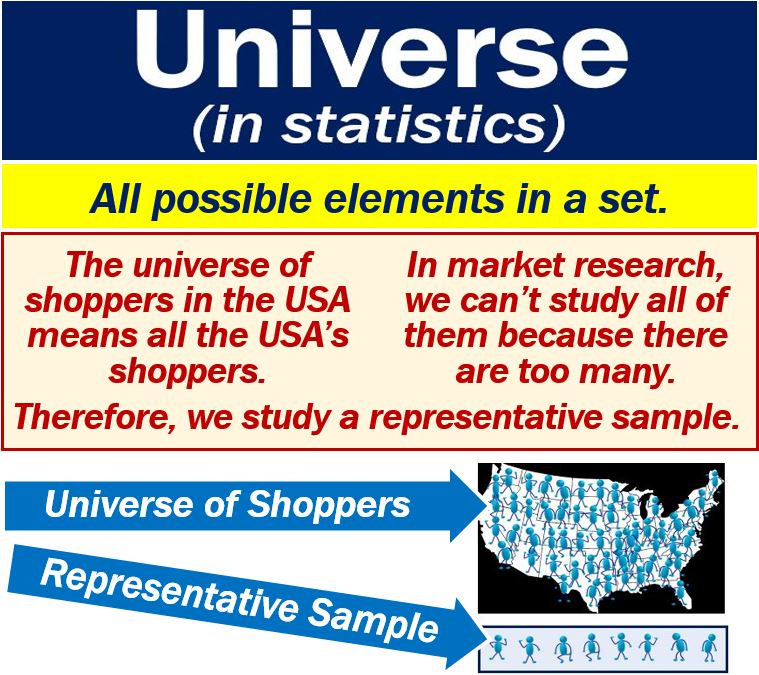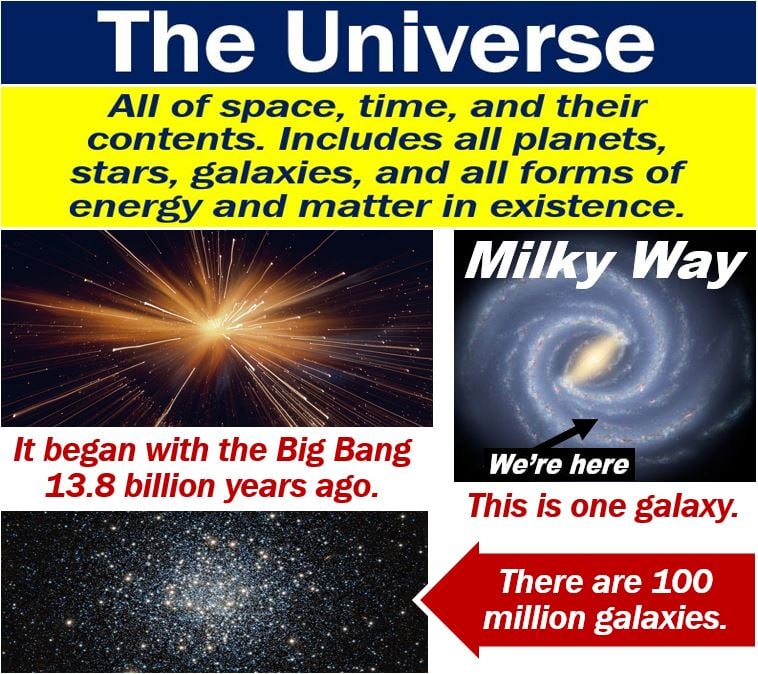The Universe is all of space including everything that exists. Our planet, all other planets in existence, stars, and galaxies are all part of the universe. It was born more than thirteen billion years ago in the Big Bang. Scientists say that it is at least ten billion light-years in diameter. In this sense, the Universe means the Cosmos.
The Universe is all time and space, i.e., spacetime. It includes all the galaxies, stars, planets, moons, and all other forms of energy and matter.
‘My universe,’ however, may refer to the world that is familiar to me. If I say, for example, “My family is my whole universe,” I mean that my family is my world.
The term may also mean a large number or quantity, as in: “We have a large enough universe of stocks to select from.”
When we talk about parallel universes, the term means realities. Some scientists believe there are parallel universes, i.e., other plains of existence. In fact, some physicists say that ours could be one out of an infinite number of universes.
The Cambridge Dictionary has the following three meanings of the word:
“1. Everything that exists, especially all physical matter, including all the stars, planets, galaxies, etc. in space.”
“2. A universe that could be imagined to exist outside our own. 3. The world, or the world that you are familiar with.”

Universe in statistics
In statistics or market research, the term represents all possible elements in a set. The universe of consumers in a country, for example, means all the consumers in that country.
When carrying out market research, analyzing all the consumers in a country with a large population is impossible. It is impossible because there are too many of them. Therefore, statisticians select a statistical sample or representative sample.
A study of shoppers in the United States, for example, if one selected the universe of shoppers, would involve hundreds of millions of people. Such a study would be impossible. However, with a representative sample of, say, 20,000 shoppers, a comprehensive study is possible.
Regarding using the term in statistics or market research, AllBusiness.com writes:
“For the purpose of market research, a subset of the population called a sample is selected from the universe to be investigated.”
“In merchandising, all buyers of ski equipment would represent the total universe for ski equipment sales.”
Market research involves gathering and analyzing data on groups of people such as customers, suppliers, or competitors. Statistics, in this context, refers to facts that statisticians present in numerical form.
When carrying out household surveys, for example, the OECD says that ‘universe’ means the same as the population. For example, the population of shoppers means all shoppers. OECD stands for Organization for Economic Co-operation and Development.
Etymology of universe
The etymology of a word is where it came from and how its meaning has evolved.
With the meaning “the whole world, cosmos, the totality of existing thing,” the English word ‘universe’ emerged in the 1580s.
It came from the Old French word Univers, which appeared in the twelfth century. The Old French word came from the Latin word Universum, meaning “all things, all people, everybody, the whole world.” Universum is the noun use of the adjective Universus, meaning “all in one, entire, whole, relating to all.”
The Latin word is a combination of Unus, meaning “one,” plus Versus, the past participle of Vertere. Vertere means “to turn, turn back, convert, transform, translate.”

The Universe – space
In astronomy, the Universe means everything, everywhere, all the time. In other words, all of space, time, and their contents. It includes all the galaxies, black holes, stars, planets, and moons. It also includes all forms of energy and matter.
Stephen Hawking (1942-2018) once said:
“Look up at the stars and not down at your feet. Try to make sense of what you see, and wonder about what makes the Universe exist. Be curious.”
Professor Hawking was a British theoretical physicist, cosmologist, author, and director of research at the Centre for Theoretical Cosmology at Cambridge University.
In 2016, Prof. Hawking suggested that black holes might be portals to other universes. Perhaps black holes are not ‘eternal prisons’ from which anything their gravity captures never escapes. He wondered whether there might be a way out.
Greek and Indian philosophers
Scientific models of universes date back to ancient Greek and Indian philosophers. They drew geocentric models that had our planet Earth at the center of everything.
Copernicus and Newton
It was not until Nicolaus Copernicus (1473-1543), a Polish astronomer and mathematician, that heliocentric models emerged. Copernicus’ model had the Sun at the center of our Solar System.
Sir Isaac Newton (1642-1727) built on Copernicus’ work when he developed the law of universal gravitation. Newton was a British mathematician, astronomer, physicist, and theologian.
Eventually, models started locating our Solar System within the Milky Way galaxy. The Milky Way is one of the cosmos’ approximately one-hundred billion galaxies.
Astronomers and astrophysicists say that the Universe has neither a center nor an edge. This is because the distribution of all the galaxies is even and the same in all directions.
According to a team of British scientists, the Universe is not spinning or stretching in any particular direction. It is expanding uniformly.
Universe has a beginning
Early in the 20th century, scientists discovered that the Universe was expanding and had a beginning.
Approximately 80% of the mass in the cosmos appears to exist in dark matter. We cannot observe dark matter, but we know it is there.
Big bang theory
The Big Bang theory is the cosmological model that most scientists believe regarding the Universe.
The model describes how our cosmos expanded from an extremely high-density and high-temperature state. The theory also explains why there is an abundance of light elements and CMB (cosmic wave background).
According to Wikipedia:
“If the known laws of physics are extrapolated to the highest density regime, the result is a singularity which is typically associated with the Big Bang.”
A singularity is a location in spacetime where a celestial body’s gravitational field becomes infinite. It becomes infinite in a way that doesn’t depend on the coordinate system.
Scientists believe that everything started from a singularity. However, they are not one-hundred percent certain. They are not certain because our current knowledge is insufficient to describe what the Universe was like at that time.
By measuring the expansion rate of the cosmos, scientists estimate that the Big Bang occurred about 13.8 billion years ago. Hence, the Universe is 13.8 billion years old.
Contemporary astronomers and cosmologists continue to explore the Universe’s mysteries, using advanced technologies like the James Webb Space Telescope to uncover deeper insights into its origins and composition.
Aside from large-scale structures and forces, researchers are investigating the mysterious nature of dark energy, which is believed to account for the accelerated expansion of the Universe.
The shape of the Universe
If we could step outside the cosmos and observe it, what would it look like? Scientists have struggled to find the answer to this question. They have taken many different measurements to determine the shape of the cosmos. They have also tried to determine whether it will come to an end.
Geometry of the cosmos
According to Albert Einstein’s theory of General Relativity, mass and energy curves and bends spacetime. By mass and energy, Einstein meant gravity.
Therefore, the density of the cosmos, i.e., how much mass there is spread over its volume, determines what it looks like. Not only does it determine its shape, but also its future.
According to Space.com:
“Scientists have calculated the ‘critical density’ of the universe. The critical density is proportional to the square of the Hubble constant, which is used in measuring the expansion rate of the universe.”
“Comparing the critical density to the actual density can help scientists to understand the cosmos.”
Video – What is the Universe?
This video, from our YouTube partner channel – Marketing Business Network, explains what ‘Universe’ means using simple and easy-to-understand language and examples.
